Timeline of Ebola virus disease
This is a timeline of Ebola, attempting to describe major events concerning the disease such as epidemics and scientific and medical progress.
Sample questions
The following are some interesting questions that can be answered by reading this timeline:
- When and where were discovered the Ebola virus strains and related viral species (Filoviridae)?
- What is the progress of the Ebola virus death rate throughout its outbreak history?
- When and where did important outbreaks take place?
- When and who developed the first vaccine against Ebola virus?
Big picture
| Year/period | Key developments |
|---|---|
| 1970s | Ebola virus is first identified. By the end of the decade, vaccine development begins.[1] |
| 2000s onwards | An increasing number of Ebola outbreaks is seen in West Africa.[2] The first vaccine is developed in 2003. |
| 2014–2016 | The largest and most complex Ebola outbreak occurs in Africa, since the virus was first discovered in 1976, with more cases and deaths in this outbreak than all others combined. Starting in Guinea, the outbreak would move across land borders to Sierra Leone and Liberia.[3] |
| 2017 | The most recent outbreak is reported in the Democratic Republic of Congo. |
Numerical and visual data
Google Scholar
The following table summarizes per-year mentions on Google Scholar as of May 22, 2021.
| Year | ebola virus | ebola vaccine | ebola treatment | ebola virus glycoprotein |
|---|---|---|---|---|
| 1980 | 641 | 379 | 291 | 15 |
| 1985 | 599 | 340 | 342 | 28 |
| 1990 | 666 | 503 | 454 | 42 |
| 1995 | 1,080 | 602 | 570 | 94 |
| 2000 | 1,860 | 951 | 1,170 | 327 |
| 2002 | 2,220 | 1,210 | 1,460 | 406 |
| 2004 | 3,050 | 1,500 | 1,950 | 662 |
| 2006 | 3,060 | 1,550 | 1,980 | 686 |
| 2008 | 3,580 | 1,800 | 2,480 | 776 |
| 2010 | 3,730 | 1,890 | 2,550 | 893 |
| 2012 | 6,620 | 1,890 | 5,860 | 1,050 |
| 2014 | 7,930 | 3,070 | 5,380 | 1,320 |
| 2016 | 13,300 | 5,530 | 10,400 | 2,210 |
| 2017 | 11,600 | 5,150 | 9,230 | 1,990 |
| 2018 | 11,800 | 5,210 | 9,620 | 2,120 |
| 2019 | 12,100 | 5,410 | 9,790 | 2,270 |
| 2020 | 29,300 | 14,200 | 23,800 | 6,060 |
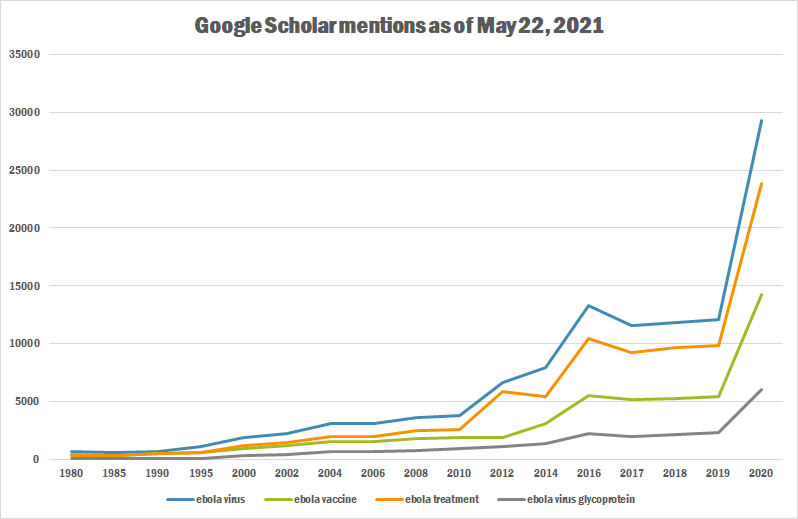
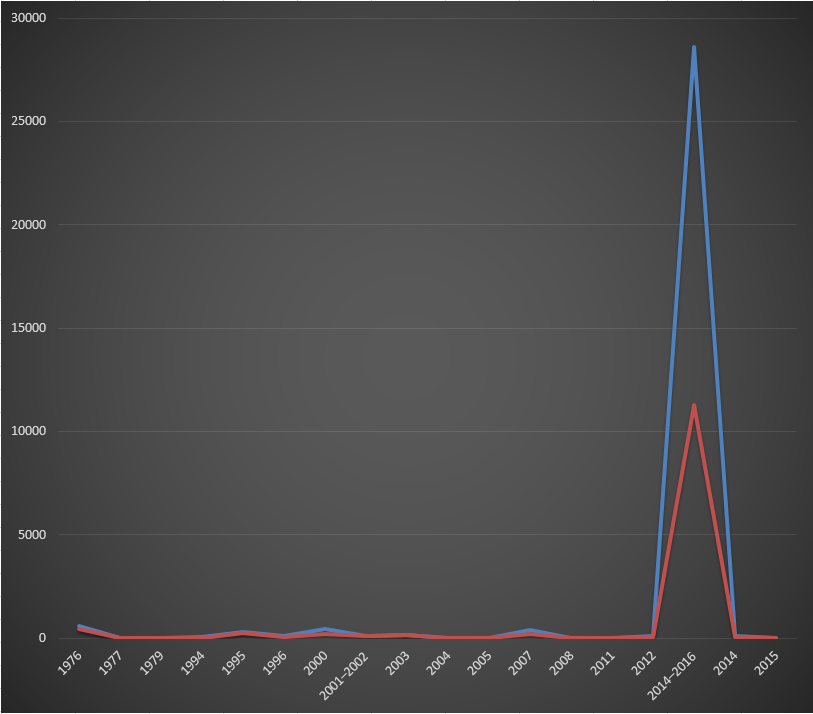
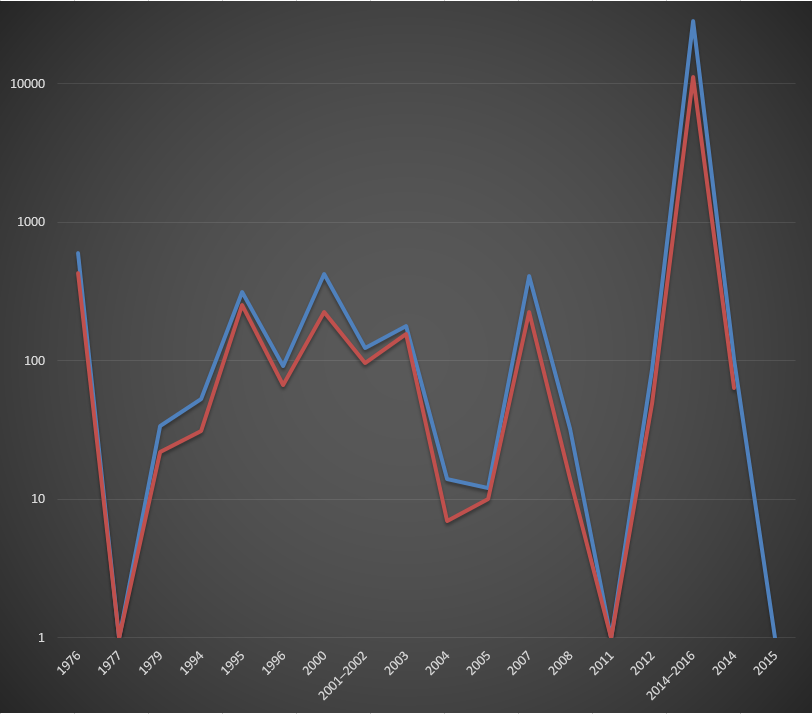
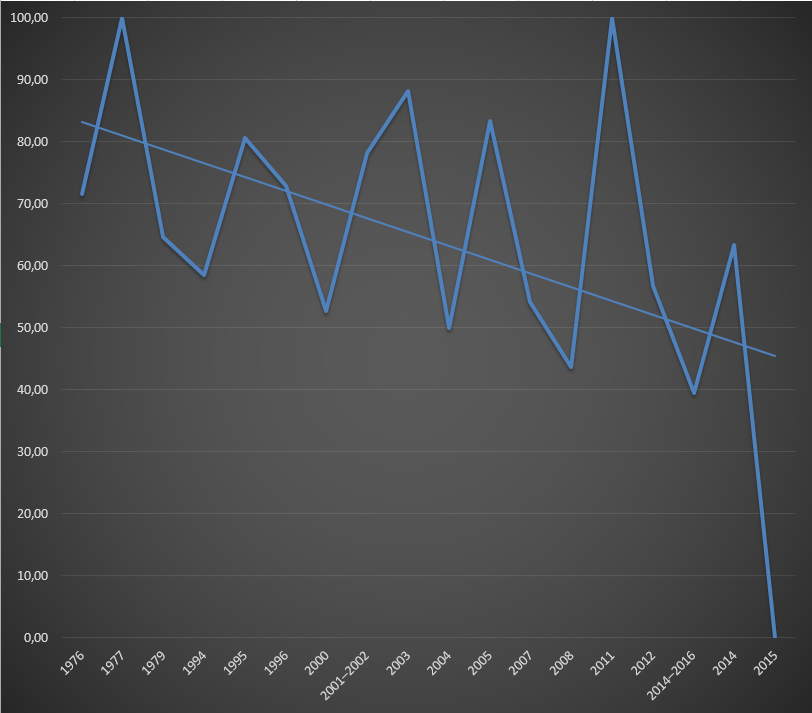
Google Trends
The image below shows Google Trends data for Ebola virus disease (Search Term), from January 2004 to January 2021, when the screenshot was taken. Interest in the topic is also ranked by country and displayed on world map.[4]
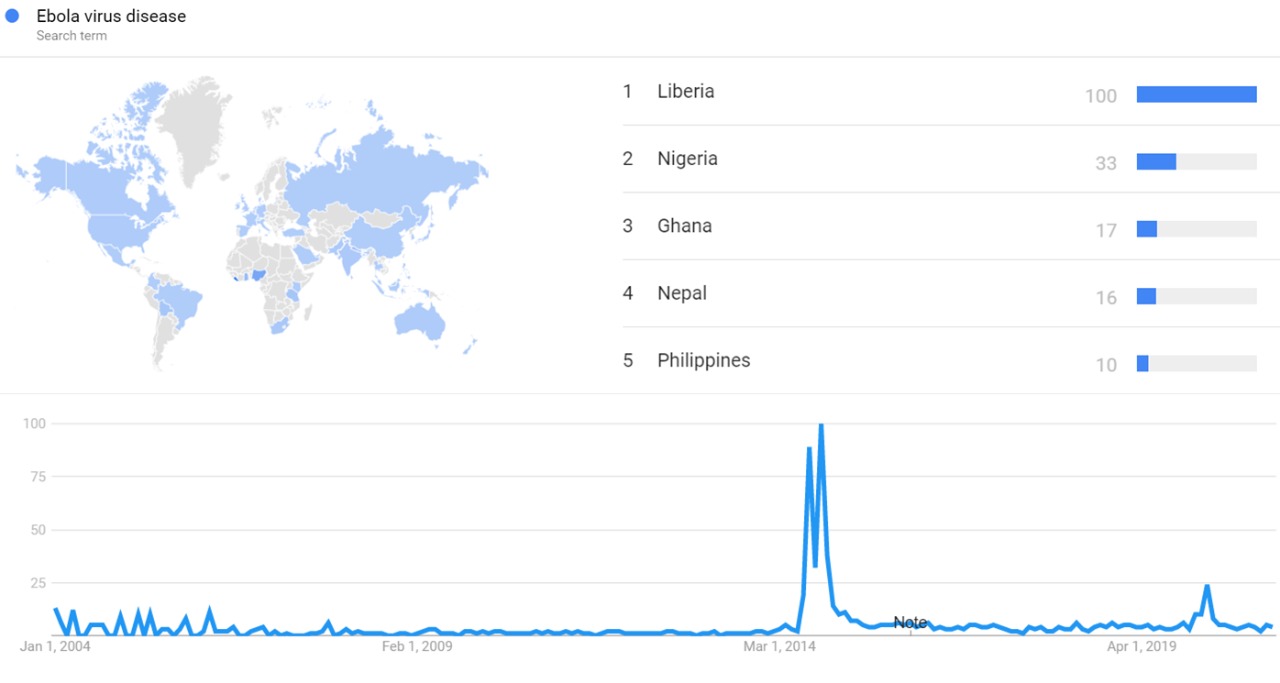
Google Ngram Viewer
The chart below shows Google Ngram Viewer data for Ebola virus disease, from 1976 to 2019.[5]
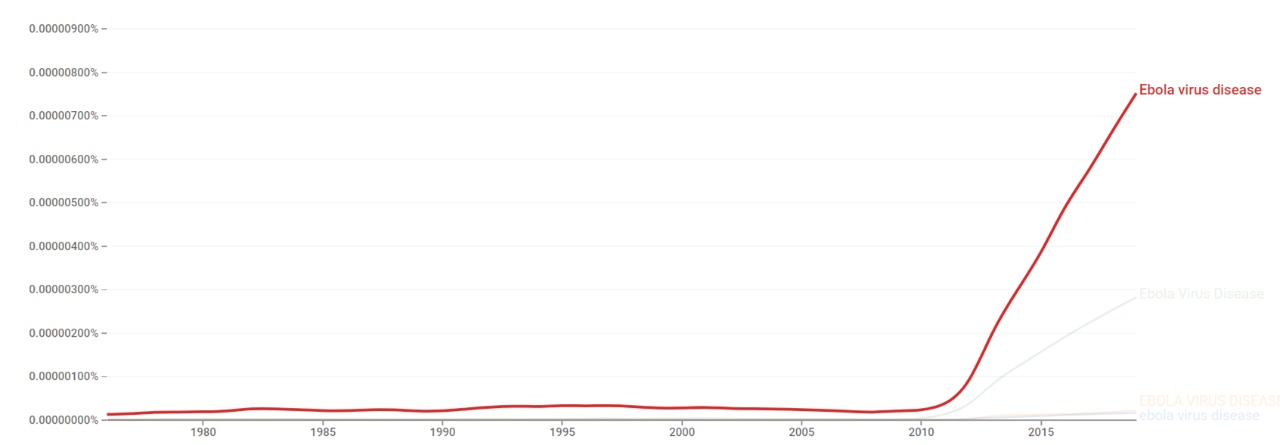
Wikipedia Views
The chart below shows pageviews of the English Wikipedia article Ebola virus disease on desktop from December 2007, and on mobile-web, desktop-spider, mobile-web-spider and mobile app, from July 2015; to January 2021.[6]
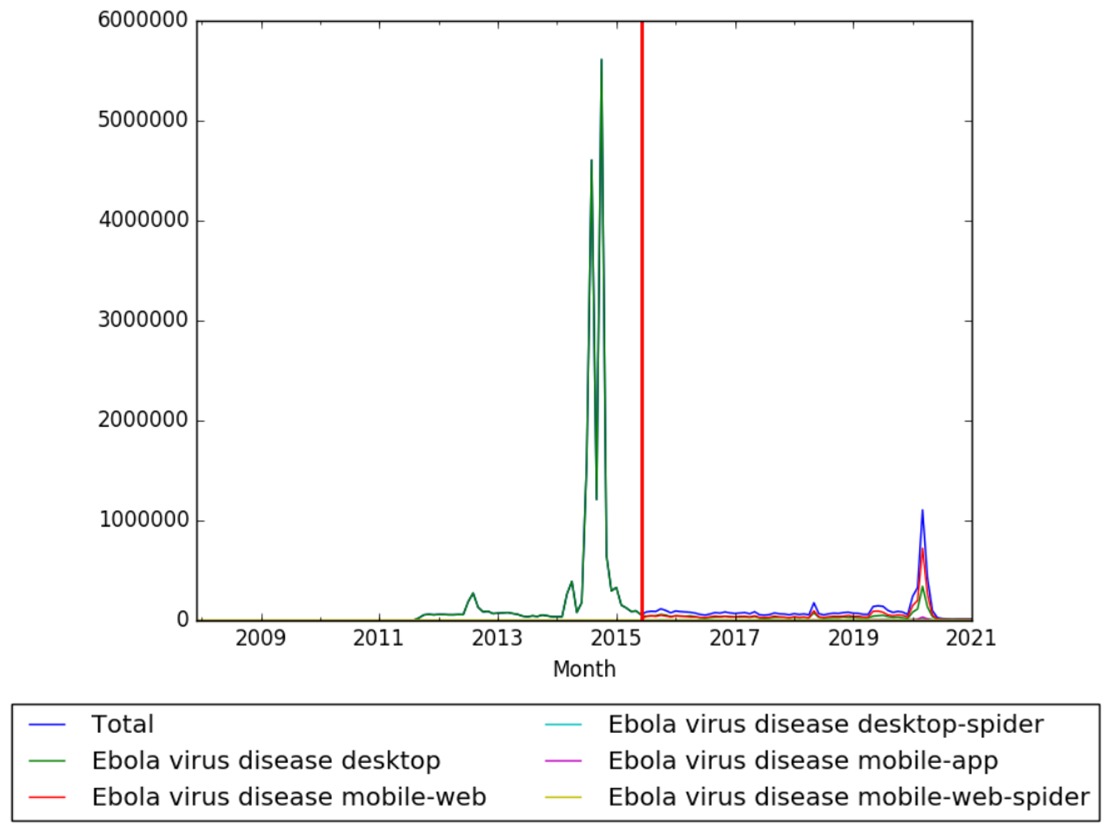
Timeline
| Year | Type of event | Event | Present time geographical location |
|---|---|---|---|
| 1967 | Outbreak | The outbreak of an unknown infectious disease is reported in Germany and Yugoslavia. An estimated 31 persons are affected, with 7 casualties. Eventually, a new strand of the virus is extracted from a patient and is traced back to a vervet monkey imported from Uganda. The disease is named Marburg disease after the town of Marburg where it was located. | Germany, Yugoslavia |
| 1976 | Outbreak | An occurrence of hemorrhagic fever, with indistinguishable symptoms from those of the Marburg disease, emerges in two simultaneous outbreaks in Nzara, Sudan, and in Yambuku, Zaire. The disease is named after the Ebola River in Zaire. The first outbreak in Sudan (Sudan ebolavirus) infects over 284 people[7], with a mortality rate of 53%. A few months later, the second outbreak, Ebola-Zaire (EBOZ) (Zaire ebolavirus), would infect 318 people[7] with a mortality rate of 88%.[8][1] Both Sudan ebolavirus and Zaire ebolavirus are first identified in these outbreaks.[7] | Sudan, Congo DR |
| 1979 | Epidemic | Ebola epidemic breaks out in Nzara and Yambio districts in Sudan. Sudan ebolavirus infects 34 people, with 22 casualties, giving a mortality rate of 64.7%. The outbreak lasts ten weeks.[7] | Sudan |
| 1989 | Discovery | Reston virus (RESTV), one of five known viruses within the genus Ebolavirus, and third in order of discovery, is first identified when infected monkeys are imported into Reston, Virginia, from Mindanao in the Philippines.[8][9][10] | United States, Philippines |
| 1994 | Discovery | Virological taxon Taï Forest ebolavirus is discovered when a female ethologist performing a necropsy on a dead chimpanzee from the Tai Forest, Cote d'Ivoire, accidentally infects herself with Ebola during the necropsy. Ths would be the last known strain of Ebola, named Ebola Cote d'Ivoire (EBO-CI).[7][11] | Côte d'Ivoire |
| 1994 | Epidemic | Ebola epidemic breaks out in the Minkouka, Andock, and Minkebe districts in Gabon. Zaire ebolavirus infects 52 people, with 31 casualties (60% mortality rate). The outbreak lasts thirteen weeks.[7][12] | Gabon |
| 1995 | Research article reports that two control non–human primates were infected with the Zaire ebolavirus without direct contact with inoculated challenged monkeys held in the same room (the most likely source of transmission can be aerosol, oral, or conjunctival exposure secreted from the infected monkeys).[2] | ||
| 1995 | Epidemic | After almost twenty years of near–absense[13], Ebola epidemic breaks out in over 30 villages in the Democratic Republic of Congo. Zaire ebolavirus infects 315 people, with 254 casualties, giving a mortality rate of 79%.[12] The outbreak lasts 27 weeks.[7] | Democratic Republic of Congo |
| 1996 | Epidemic | Two epidemics of Zaire ebolavirus, occurring in spring and fall, break out in Ogooué-Ivindo Province in Gabon; combining 91 cases with 66 casualties and a mortality rate at 72%.[12][14] | Gabon |
| 1996 | Outbreak | Two people are infected with Zaire ebolavirus in Johannesburg. Both are killed by the disease.[7] | South Africa |
| 2000 | Epidemic | Ebola epidemic breaks out in Gulu, Masindi, Mbarara districts in Uganda. Sudan ebolavirus infects 425 people, with 224 casualties, giving a mortality rate of 53%.[12] The outbreak lasts 20 weeks.[7] | Uganda |
| 2001–2002 | Epidemic | Ebola epidemic breaks out in Gabon and the Republic of Congo. Zaire ebolavirus infects 124 people, with 97 casualties, giving a mortality rate of 78%.[12] | Gabon, Republic of Congo |
| 2002–2003 | Epidemic | Ebola epidemic breaks out in the Mbomo district and Kellé district in the Republic of Congo. Zaire ebolavirus infects 143 people, with 128 casualties, giving a mortality rate of 89%.[12] The outbreak lasts 17 weeks.[7] | Republic of Congo |
| 2003 | Epidemic | Another Zaire ebolavirus epidemic breaks out in the Mbomo district and Mbandza district in the Republic of Congo, with 35 infected people and 29 casualties (82.8% case fatality rate). The outbreak lasts 7 weeks.[12][7] | Republic of Congo |
| 2003 | Vaccine | Scientists working at Canada’s National Microbiology Laboratory in Winnipeg create an experimental vaccine (called VSV-ZEBOV) that shows highly effective response against Ebola.[15][16] The same year, the Public Health Agency of Canada patents the vaccine.[17] | Canada |
| 2004 | Epidemic | Sudan ebolavirus epidemic breaks out in Sudan, infecting 17 people, with 7 casualties, and a mortality rate of 41%.[12] | Sudan |
| 2005 | Scientific discovery | Research team working at the Centre International de Recherches Médicales de Franceville in Gabon, after collecting over 1,000 birds, bats and small terrestrial mammals in the vicinity of an ongoing Ebola outbreak among gorillas and chimpanzees, discovers that individual bats of three species (Hypsignathus monstruosus, Epomops franqueti and Myonycteris torquata) contain antibodies against Ebola virus, indicating past infection.[13] | Gabon |
| 2005 | Epidemic | Zaire ebolavirus epidemic breaks out in the Republic of Congo, infecting 12 people, with 10 casualties, and a mortality rate of 75%.[12] | Republic of Congo |
| 2006 | Study | Study reveals that Ebola would be more frequent with global warming due to its intermittent connection to wildlife and climate.[18] | |
| 2007 | Epidemic | Zaire ebolavirus epidemic breaks out in the Democratic Republic of Congo, infecting 264 people, with 187 casualties, and a mortality rate of 71%.[12] The outbreak lasts 17 weeks.[7] | Democratic Republic of Congo |
| 2007 | Epidemic | The first known Ebola hemorrhagic fever (EHF) outbreak caused by Bundibugyo Ebolavirus occurs in Bundibugyo District, Uganda, from where it takes its name.[19] 149 cases are confirmed, with 37 casualties and a mortality rate of 25%.[12] Bundibugyo Ebolavirus is identified for the first time in this outbreak.[7] | Uganda |
| 2008–2009 | Reston ebolavirus is detected in domestic pigs and pig workers in the Philippines.[9] | Philippines | |
| 2008–2009 | Epidemic | Zaire ebolavirus epidemic breaks out in the Democratic Republic of Congo, infecting 32 people, with 14 casualties, and a mortality rate of 47%.[12] | Democratic Republic of Congo |
| 2010 | Discovery | Lloviu cuevavirus, a distant relative of Ebola virus and Marburg virus, is discovered in Spain.[7] | Spain |
| 2012 (June–August) | Epidemic | Sudan ebolavirus epidemic breaks out in the Kibaale District in Uganda, infecting 24 people, with 17 casualties, and a mortality rate of 71%.[12][20] | Uganda |
| 2013 (December) | Epidemic | The West African Ebola virus epidemic begins in Guéckédou, Guinea. This is the most severe Ebola outbreak recorded in regards to both the number of human cases and fatalities. The Zaire ebolavirus epidemic would further spread to Liberia, Sierra Leone and Guinea, with limited and local cases in Nigeria, Mali, United States, Senegal, Spain, United Kingdom and Italy.[21][22][12] | Guinea |
| 2014 (March 23) | Report | West African Ebola virus epidemic: The World Health Organization publishes the first report on the Ebola outbreak in Guinea. The report describes measures taken by the Guinean Ministry of Health, together with WHO and other partners, to control the outbreak and prevent further spread.[23] | |
| 2014 (March 28) | Campaign | West African Ebola virus epidemic: The Global Outbreak Alert and Response Network (GOARN) becomes the first team to deploy workforce in response to the outbreak in Guinea, sending 895 experts, including doctors, nurses, infection control specialists, logisticians, laboratory specialists; communication, anthropology and social mobilisation experts, emergency management and public health professionals among others.[24] | Guinea |
| 2014 (July 20) | West African Ebola virus epidemic: An airline passenger from Liberia introduces the Ebola virus into Lagos, Nigeria, marking the first time that Ebola enters a new country via international air travel.[23] | Nigeria | |
| 2014 (August–November) | Epidemic | Zaire ebolavirus epidemic (not linked to the West African Ebola virus epidemic) breaks out in the Democratic Republic of Congo (see 2014 Democratic Republic of the Congo Ebola virus outbreak, infecting 57 people, with 29 casualties, and a mortality rate of 55%.[12] | Democratic Republic of Congo |
| 2014 (September) | Campaign | United States President Barack Obama announces plan to send 3,000 Troops to Liberia in response to Ebola epidemic.[25] | |
| 2014 (September 14) | Outbreak | A total of 4,507 probable and confirmed cases, including 2,296 deaths from Zaire ebolavirus (EBOV) are reported from five countries in West Africa.[2] | Guinea, Liberia, Nigeria, Senegal and Sierra Leone |
| 2014 (November) | License | American pharmaceutical company Merck & Co. announces US$50 million payment for commercial rights to manufacture and develop the rVSV-ZEBOV vaccine.[17] | United States |
| 2015 (May 9) | Report | The World Health Organization first declares Liberia free of Ebola virus transmission. The country would subsequently experience a cluster of six Ebola cases in June, until new declaration of free of transmission status is communicated again on September 3.[26] | Liberia |
| 2015 (November–December) | Report | The World Health Organization declares Sierra Leone free of Ebola virus transmission. This would be after 42 days (two incubation periods) passed since the last Ebola patient tested negative. Under the same criterion, on December 29 Guinea is also declared free of Ebola virus transmission.[26] | Sierra Leone, Guinea |
| 2016 (January 14) | The West African Ebola virus epidemic is declared ended.[27] In May 2016, the World Health Organization and respective governments would report a total of 28,616 suspected cases and 11,310 deaths (mortality rate at 39.5%).[28] | West Africa | |
| 2016 (March) | Campaign | Nearly 800 people are ring vaccinated on an emergency basis with rVSV-ZEBOV vaccine when another Ebola outbreak occurs in Guinea.[29] | Guinea |
| 2016 (March 17) | Report | The World Health Organization declares end of Ebola transmission in Sierra Leone. A total of 14,122 cases with 3,955 fatalities are reported.[30] | Sierra Leone |
| 2016 (March 29) | Policy | The World Health Organization terminates the Public Health Emergency of International Concern (PHEIC) for the Ebola outbreak in West Africa.[31] | |
| 2016 (June 1) | Report | The World Health Organization declares end of Ebola transmission in Guinea. A total of 3,804 cases with 2,536 fatalities are reported.[32] | Guinea |
| 2016 (June 9) | Report | The World Health Organization declares end of Ebola transmission in Liberia. A total of 10,666 cases with 4,806 fatalities are reported.[32] | Liberia |
| 2016 (December) | Report | Vaccination trial against Ebola virus in Guinea is reported successful. Led by the World Health Organization in conjunction with Guinea's Ministry of Health, the VSV-EBOV vaccine trial is found to be 70–100% effective against the Ebola virus, making it the first vaccine against the disease.[33][34] The trial would involve more than 11,000 people.[35] | Guinea |
| 2017 (May) | Campaign | The World Health Organization identifies new outbreak in the Democratic Republic of the Congo. In the face of the new outbreak, the Ministry of Health approves emergency use of rVSV-ZEBOV vaccine.[36] | Democratic Republic of the Congo |
| 2017 (May) | Director-General of the World Health Organization Margaret Chan announces that "the world is far better prepared for another Ebola outbreak", following the success of the vaccine trial in Guinea.[37] |
See also
External links
References
- ↑ 1.0 1.1 "Ebola Virus Disease and Ebola Vaccines". historyofvaccines.org. Retrieved 30 June 2017.
- ↑ 2.0 2.1 2.2 Gebrea, Yitades; Gebre, Teshome; Peters, Abena. "The Ebola virus: a review of progress and development in research". doi:10.12980/APJTB.4.201414B419. Retrieved 30 June 2017.
{{cite journal}}: Cite journal requires|journal=(help) - ↑ "Ebola virus disease". who.int. Retrieved 29 June 2017.
- ↑ "Ebola virus disease". Google Trends. Retrieved 15 February 2021.
- ↑ "Ebola virus disease". books.google.com. Retrieved 16 February 2021.
- ↑ "Ebola virus disease". wikipediaviews.org. Retrieved 21 February 2021.
- ↑ 7.00 7.01 7.02 7.03 7.04 7.05 7.06 7.07 7.08 7.09 7.10 7.11 7.12 7.13 "Outbreaks of Ebola virus disease in Africa: the beginnings of a tragic saga". scielo.br. Retrieved 16 July 2017.
- ↑ 8.0 8.1 "Brief General History of Ebola". stanford.edu. Retrieved 29 June 2017.
- ↑ 9.0 9.1 Jayme, Sarah I.; et al. "Molecular evidence of Ebola Reston virus infection in Philippine bats". Virology Journal. doi:10.1186/s12985-015-0331-3. Retrieved 3 July 2017.
{{cite journal}}: Explicit use of et al. in:|last1=(help)CS1 maint: unflagged free DOI (link) - ↑ "Ebola Reston Outbreaks". stanford.edu. Retrieved 16 July 2017.
- ↑ Erdem, Hakan; Ünal, Serhat. "New global viral threats". PMC 4404471. Retrieved 17 July 2017.
Interestingly, the Tai Forest virus has only been identified in one ethologist who performed a necropsy on a chimpanzee found dead in the Tai Forest.
{{cite journal}}: Cite journal requires|journal=(help) - ↑ 12.00 12.01 12.02 12.03 12.04 12.05 12.06 12.07 12.08 12.09 12.10 12.11 12.12 12.13 12.14 "Ebola: overview, history, origins and transmission". www.gov.uk. Retrieved 30 June 2017.
- ↑ 13.0 13.1 Evans, Nicholas G.; Smith, Tara C. Ebola's Message: Public Health and Medicine in the Twenty-First Century. Retrieved 3 July 2017.
- ↑ "Ebola Hemorrhagic Fever Outbreaks in Gabon, 1994–1997: Epidemiologic and Health Control Issues". doi:10.1086/514290. Retrieved 30 June 2017.
{{cite journal}}: Cite journal requires|journal=(help) - ↑ "Winnipeg lab made world's first effective Ebola vaccine". winnipegsun.com. Retrieved 14 July 2017.
- ↑ "Ebola vaccine developed in Canada shows promising results". sciencedaily.com. Retrieved 14 July 2017.
- ↑ 17.0 17.1 "The strange tale of Canada's ebola vaccine: Walkom". thestar.com. Retrieved 17 July 2017.
- ↑ "Ebola and Climate Change: How Are They Connected?". ecowatch.com. Retrieved 14 July 2017.
- ↑ MacNeil, Adam; et al. "Proportion of Deaths and Clinical Features in Bundibugyo Ebola Virus Infection, Uganda". doi:10.3201/eid1612.100627. PMC 3294552. Retrieved 3 July 2017.
{{cite journal}}: Cite journal requires|journal=(help); Explicit use of et al. in:|last1=(help) - ↑ World Health Organization (4 October 2012). "End of Ebola outbreak in Uganda". Geneva, Switzerland: World Health Organization. Retrieved 3 July 2017.
- ↑ "Tracing Ebola's Breakout to an African 2-Year-Old". New York Times. Retrieved 3 July 2017.
- ↑ WHO Ebola Response Team (23 September 2014). "Ebola Virus Disease in West Africa — The First 9 Months of the Epidemic and Forward Projections". New England Journal of Medicine. Retrieved 3 July 2017.
- ↑ 23.0 23.1 "Key events in the WHO response to the Ebola outbreak". who.int. Retrieved 18 July 2017.
- ↑ "Partners: Global Outbreak Alert and Response Network (GOARN)". who.int. Retrieved 18 July 2017.
- ↑ "Obama to Send 3,000 Troops to Liberia in Ebola Fight". voanews.com. Retrieved 12 July 2017.
- ↑ 26.0 26.1 "2014 Ebola Outbreak in West Africa - Case Counts". cdc.gov. Retrieved 30 June 2017.
- ↑ "Ebola". doctorswithoutborders.org. Retrieved 30 June 2017.
- ↑ "Ebola data and statistics". World Health Organisation. Retrieved 3 July 2017.
- ↑ "WHO coordinating vaccination of contacts to contain Ebola flare-up in Guinea". World Health Organization. March 2016. Retrieved 17 July 2017.
- ↑ "Ebola Situation Report – 16 March 2016 | Ebola". apps.who.int. World Health Organization. Retrieved 3 July 2017.
- ↑ "2014-2016 Ebola Outbreak in West Africa". cdc.gov. Retrieved 16 July 2017.
- ↑ 32.0 32.1 "End of Ebola transmission in Guinea". WHO Regional Office for Africa. 2015. Retrieved 3 July 2017.
- ↑ Henao-Restrepo, Ana Maria; et al. (22 December 2016). "Efficacy and effectiveness of an rVSV-vectored vaccine in preventing Ebola virus disease: final results from the Guinea ring vaccination, open-label, cluster-randomised trial (Ebola Ça Suffit!)". The Lancet. 389 (10068): 505–518. doi:10.1016/S0140-6736(16)32621-6. PMC 5364328. PMID 28017403. Retrieved 17 July 2016.
{{cite journal}}: Explicit use of et al. in:|author=(help) - ↑ Berlinger, Joshua (22 December 2016). "Ebola vaccine gives 100% protection, study finds". CNN. Retrieved 17 July 2016.
- ↑ "Ebola vaccine gives 100% protection, study finds". cnn.com. Retrieved 17 July 2017.
- ↑ Maxmen, Amy. "Ebola vaccine approved for use in ongoing outbreak". Nature. doi:10.1038/nature.2017.22024. Retrieved 17 July 2017.
- ↑ "Leaders gather in Guinea to celebrate Ebola vaccine successes". who.int. Retrieved 30 June 2017.